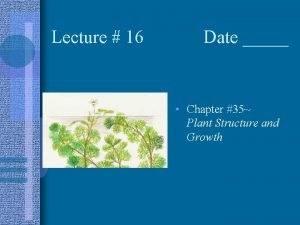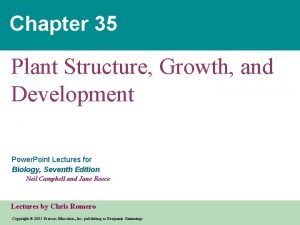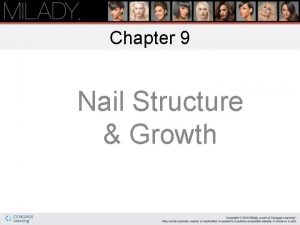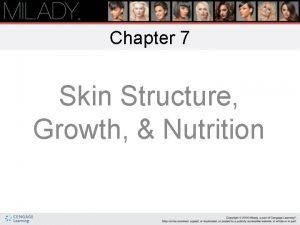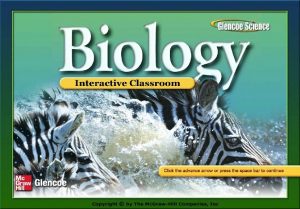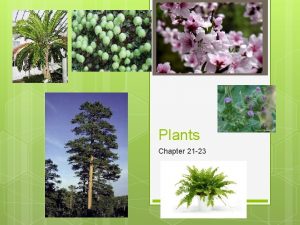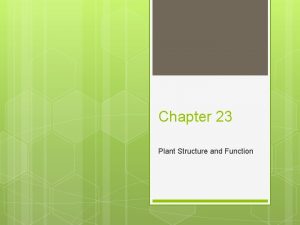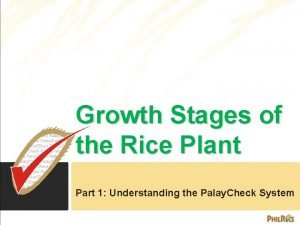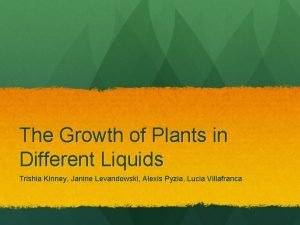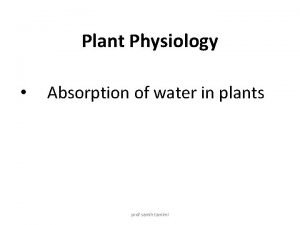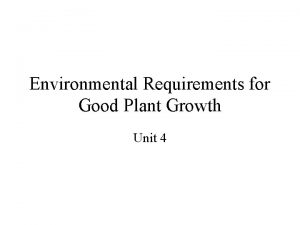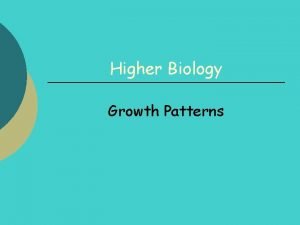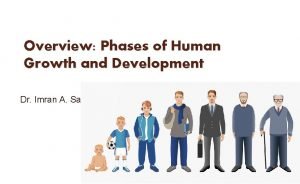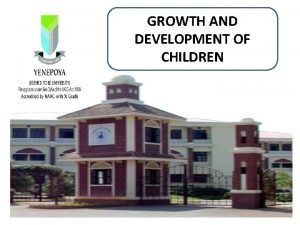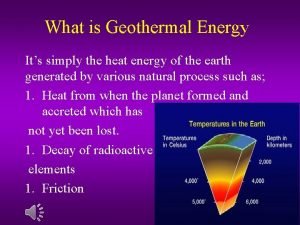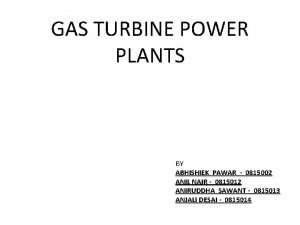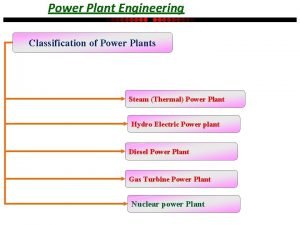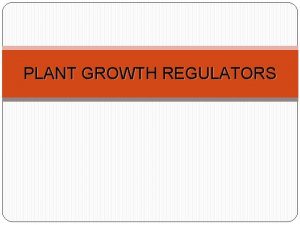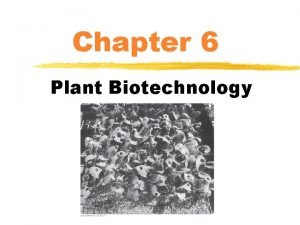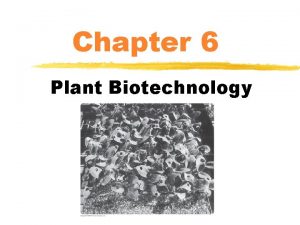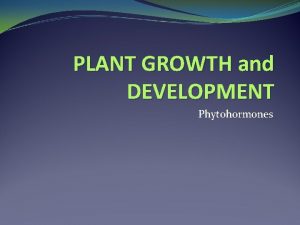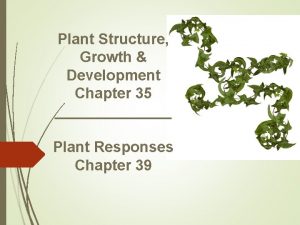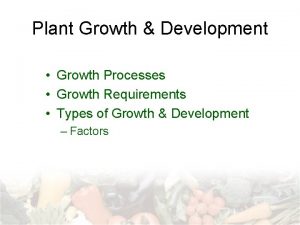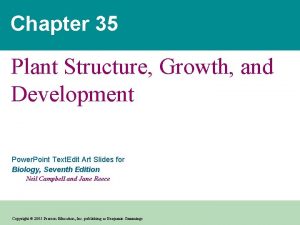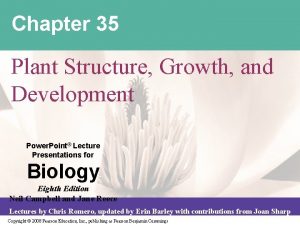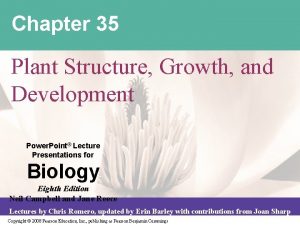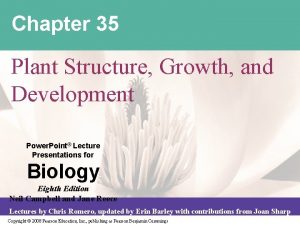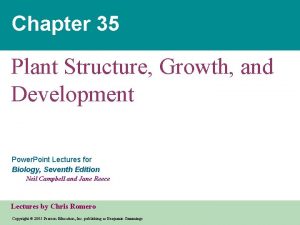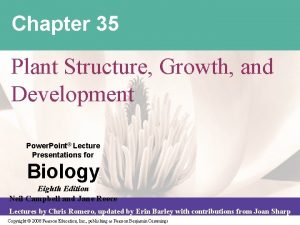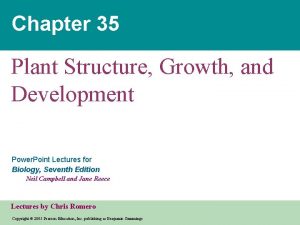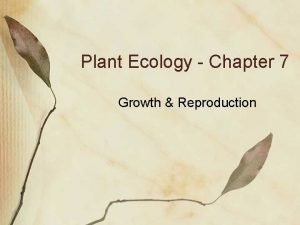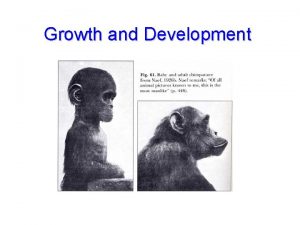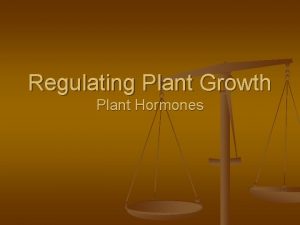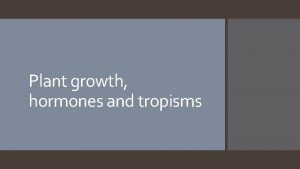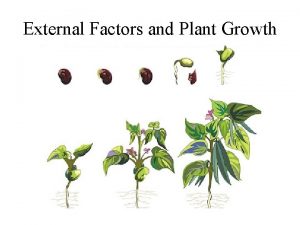Chapter 35 Plant Structure Growth and Development Power










































































- Slides: 74

Chapter 35 Plant Structure, Growth, and Development Power. Point Lectures for Biology, Seventh Edition Neil Campbell and Jane Reece Lectures by Chris Romero Copyright © 2005 Pearson Education, Inc. publishing as Benjamin Cummings

• Overview: No two Plants Are Alike • To some people – The fanwort is an intrusive weed, but to others it is an attractive aquarium plant • This plant exhibits plasticity – The ability to alter itself in response to its environment Figure 35. 1 Copyright © 2005 Pearson Education, Inc. publishing as Benjamin Cummings

• In addition to plasticity – Entire plant species have by natural selection accumulated characteristics of morphology that vary little among plants within the species Copyright © 2005 Pearson Education, Inc. publishing as Benjamin Cummings

• Concept 35. 1: The plant body has a hierarchy of organs, tissues, and cells • Plants, like multicellular animals – Have organs composed of different tissues, which are in turn composed of cells Copyright © 2005 Pearson Education, Inc. publishing as Benjamin Cummings

The Three Basic Plant Organs: Roots, Stems, and Leaves • The basic morphology of vascular plants – Reflects their evolutionary history as terrestrial organisms that draw nutrients from two very different environments: below-ground above-ground Copyright © 2005 Pearson Education, Inc. publishing as Benjamin Cummings

• Three basic organs evolved: roots, stems, and leaves • They are organized into a root system and a shoot system Reproductive shoot (flower) Terminal bud Node Internode Terminal bud Shoot system Vegetative shoot Leaf Blade Petiole Axillary bud Stem Taproot Lateral roots Figure 35. 2 Copyright © 2005 Pearson Education, Inc. publishing as Benjamin Cummings Root system

Roots • A root – Is an organ that anchors the vascular plant – Absorbs minerals and water – Often stores organic nutrients Copyright © 2005 Pearson Education, Inc. publishing as Benjamin Cummings

• In most plants – The absorption of water and minerals occurs near the root tips, where vast numbers of tiny root hairs increase the surface area of the root Figure 35. 3 Copyright © 2005 Pearson Education, Inc. publishing as Benjamin Cummings

• Many plants have modified roots (a) Prop roots Figure 35. 4 a–e (d) Buttress roots Copyright © 2005 Pearson Education, Inc. publishing as Benjamin Cummings (b) Storage roots (c) “Strangling” aerial roots (e) Pneumatophores

Stems • A stem is an organ consisting of – An alternating system of nodes, the points at which leaves are attached – Internodes, the stem segments between nodes Copyright © 2005 Pearson Education, Inc. publishing as Benjamin Cummings

• An axillary bud – Is a structure that has the potential to form a lateral shoot, or branch • A terminal bud – Is located near the shoot tip and causes elongation of a young shoot Copyright © 2005 Pearson Education, Inc. publishing as Benjamin Cummings

• Many plants have modified stems (a) Stolons. Shown here on a strawberry plant, stolons are horizontal stems that grow along the surface. These “runners” enable a plant to reproduce asexually, as plantlets form at nodes along each runner. Storage leaves Stem (d) Rhizomes. The edible base of this ginger plant is an example of a rhizome, a horizontal stem that grows just below the surface or emerges and grows along the surface. Node Root Figure 35. 5 a–d (b) Bulbs are vertical, underground shoots consisting (c) Tubers, such as these mostly of the enlarged bases red potatoes, are enlarged of leaves that store food. You ends of rhizomes specialized can see the many layers of for storing food. The “eyes” modified leaves attached arranged in a spiral pattern to the short stem by slicing an around a potato are clusters onion bulb lengthwise. of axillary buds that mark the nodes. Copyright © 2005 Pearson Education, Inc. publishing as Benjamin Cummings Rhizome Root

Leaves • The leaf – Is the main photosynthetic organ of most vascular plants Copyright © 2005 Pearson Education, Inc. publishing as Benjamin Cummings

• Leaves generally consist of – A flattened blade and a stalk – The petiole, which joins the leaf to a node of the stem Copyright © 2005 Pearson Education, Inc. publishing as Benjamin Cummings

• Monocots and dicots – Differ in the arrangement of veins, the vascular tissue of leaves • Most monocots – Have parallel veins • Most dicots – Have branching veins Copyright © 2005 Pearson Education, Inc. publishing as Benjamin Cummings

• In classifying angiosperms – Taxonomists may use leaf morphology as a leaf. A simple leaf criterion (a) is. Simple a single, undivided blade. Some simple leaves are deeply lobed, as in an oak leaf. Petiole (b) Compound leaf. In a compound leaf, the blade consists of multiple leaflets. Notice that a leaflet has no axillary bud at its base. (c) Doubly compound leaf. In a doubly compound leaf, each leaflet is divided into smaller leaflets. Figure 35. 6 a–c Copyright © 2005 Pearson Education, Inc. publishing as Benjamin Cummings Axillary bud Leaflet Petiole Axillary bud

• Some plant species – Have evolved modified leaves that serve various functions (a) Tendrils. The tendrils by which this pea plant clings to a support are modified leaves. After it has “lassoed” a support, a tendril forms a coil that brings the plant closer to the support. Tendrils are typically modified leaves, but some tendrils are modified stems, as in grapevines. (b) Spines. The spines of cacti, such as this prickly pear, are actually leaves, and photosynthesis is carried out mainly by the fleshy green stems. (c) Storage leaves. Most succulents, such as this ice plant, have leaves modified for storing water. (d) Bracts. Red parts of the poinsettia are often mistaken for petals but are actually modified leaves called bracts that surround a group of flowers. Such brightly colored leaves attract pollinators. Figure 35. 6 a–e (e) Reproductive leaves. The leaves of some succulents, such as Kalanchoe daigremontiana, produce adventitious plantlets, which fall off the leaf and take root in the soil. Copyright © 2005 Pearson Education, Inc. publishing as Benjamin Cummings

The Three Tissue Systems: Dermal, Vascular, and Ground • Each plant organ – Has dermal, vascular, and ground tissues Dermal tissue Figure 35. 8 Copyright © 2005 Pearson Education, Inc. publishing as Benjamin Cummings Ground tissue Vascular tissue

• The dermal tissue system – Consists of the epidermis and periderm Copyright © 2005 Pearson Education, Inc. publishing as Benjamin Cummings

• The vascular tissue system – Carries out long-distance transport of materials between roots and shoots – Consists of two tissues, xylem and phloem Copyright © 2005 Pearson Education, Inc. publishing as Benjamin Cummings

• Xylem – Conveys water and dissolved minerals upward from roots into the shoots • Phloem – Transports organic nutrients from where they are made to where they are needed Copyright © 2005 Pearson Education, Inc. publishing as Benjamin Cummings

• Ground tissue – Includes various cells specialized for functions such as storage, photosynthesis, and support Copyright © 2005 Pearson Education, Inc. publishing as Benjamin Cummings

Common Types of Plant Cells • Like any multicellular organism – A plant is characterized by cellular differentiation, the specialization of cells in structure and function Copyright © 2005 Pearson Education, Inc. publishing as Benjamin Cummings

• Some of the major types of plant cells include – Parenchyma – Collenchyma – Sclerenchyma – Water-conducting cells of the xylem – Sugar-conducting cells of the phloem Copyright © 2005 Pearson Education, Inc. publishing as Benjamin Cummings

• Parenchyma, collenchyma, and sclerenchyma cells PARENCHYMA CELLS COLLENCHYMA CELLS 80 m Cortical parenchyma cells SCLERENCHYMA CELLS 5 m Sclereid cells in pear 25 m Cell wall Parenchyma cells 60 m Collenchyma cells Fiber cells Figure 35. 9 Copyright © 2005 Pearson Education, Inc. publishing as Benjamin Cummings

• Water-conducting cells of the xylem and sugarconducting cells of the phloem WATER-CONDUCTING CELLS OF THE XYLEM Vessel Tracheids SUGAR-CONDUCTING CELLS OF THE PHLOEM Sieve-tube members: longitudinal view 100 m Pits Companion cell Sieve-tube member Sieve plate Tracheids and vessels Vessel elements with partially perforated end walls Nucleus 30 m 15 m Tracheids Cytoplasm Figure. 35. 9 Copyright © 2005 Pearson Education, Inc. publishing as Benjamin Cummings Companion cell

• Concept 35. 2: Meristems generate cells for new organs • Apical meristems – Are located at the tips of roots and in the buds of shoots – Elongate shoots and roots through primary growth Copyright © 2005 Pearson Education, Inc. publishing as Benjamin Cummings

• Lateral meristems – Add thickness to woody plants through secondary growth Copyright © 2005 Pearson Education, Inc. publishing as Benjamin Cummings

• An overview of primary and secondary growth Primary growth in stems Shoot apical meristems (in buds) Epidermis Cortex Primary phloem In woody plants, there are lateral meristems that add secondary growth, increasing the girth of roots and stems. Vascular cambium Cork cambium Primary xylem Lateral meristems Pith Secondary growth in stems Apical meristems add primary growth, or growth in length. Pith Primary xylem Root apical meristems Figure. 35. 10 Copyright © 2005 Pearson Education, Inc. publishing as Benjamin Cummings Secondary xylem Periderm Cork cambium The cork cambium adds secondary dermal tissue. Cortex Primary phloem The vascular cambium adds Secondary secondary phloem xylem and Vascular cambium phloem.

• In woody plants – Primary and secondary growth occur simultaneously but in different locations Terminal bud Bud scale Axillary buds Leaf scar Node This year’s growth (one year old) Stem Internode One-year-old side branch formed from axillary bud near shoot apex Leaf scar Last year’s growth (two years old) Figure 35. 11 Growth of two years ago (three years old) Copyright © 2005 Pearson Education, Inc. publishing as Benjamin Cummings Scars left by terminal bud scales of previous winters Leaf scar

• Concept 35. 3: Primary growth lengthens roots and shoots • Primary growth produces the primary plant body, the parts of the root and shoot systems produced by apical meristems Copyright © 2005 Pearson Education, Inc. publishing as Benjamin Cummings

Primary Growth of Roots • The root tip is covered by a root cap, which protects the delicate apical meristem as the root pushes through soil during primary growth Cortex Vascular cylinder Epidermis Key Root hair Dermal Ground Zone of maturation Vascular Zone of elongation Apical meristem Root cap Figure 35. 12 100 m Copyright © 2005 Pearson Education, Inc. publishing as Benjamin Cummings Zone of cell division

• The primary growth of roots – Produces the epidermis, ground tissue, and vascular tissue Copyright © 2005 Pearson Education, Inc. publishing as Benjamin Cummings

• Organization of primary tissues in young roots Epidermis Cortex Vascular cylinder Endodermis Pericycle Core of parenchyma cells Xylem 100 m Phloem 100 m (a) Transverse section of a typical root. In the roots of typical gymnosperms and eudicots, as well as some monocots, the stele is a vascular cylinder consisting of a lobed core of xylem with phloem between the lobes. Endodermis Pericycle Xylem Phloem Figure 35. 13 a, b 50 m Copyright © 2005 Pearson Education, Inc. publishing as Benjamin Cummings (b) Transverse section of a root with parenchyma in the center. The stele of many monocot roots is a vascular cylinder with a core of parenchyma surrounded by a ring of alternating xylem and phloem. Key Dermal Ground Vascular

• Lateral roots – Arise from within the pericycle, the outermost cell layer in the vascular cylinder 100 m Emerging lateral root Cortex 1 Vascular cylinder 2 Epidermis Lateral root Figure 35. 14 3 Copyright © 2005 Pearson Education, Inc. publishing as Benjamin Cummings 4

Primary Growth of Shoots • A shoot apical meristem – Is a dome-shaped mass of dividing cells at the tip of the terminal bud – Gives rise to a repetition of internodes and leaf Apical meristem Leaf primordia -bearing nodes Developing vascular strand Axillary bud meristems Figure. 35. 15 0. 25 mm Copyright © 2005 Pearson Education, Inc. publishing as Benjamin Cummings

Tissue Organization of Stems • In gymnosperms and most eudicots – The vascular tissue consists of vascular bundles arranged in a ring Phloem Xylem Sclerenchyma (fiber cells) Ground tissue connecting pith to cortex Pith Key Cortex Epidermis Vascular bundle Ground 1 mm Figure 35. 16 a Dermal Vascular (a) A eudicot stem (sunflower), with vascular bundles forming a ring. Ground tissue toward the inside is called pith, and ground tissue toward the outside is called cortex. (LM of transverse section) Copyright © 2005 Pearson Education, Inc. publishing as Benjamin Cummings

• In most monocot stems – The vascular bundles are scattered throughout the ground tissue, rather than forming a ring Ground tissue Epidermis Vascular bundles 1 mm Figure 35. 16 b (b) A monocot stem (maize) with vascular bundles scattered throughout the ground tissue. In such an arrangement, ground tissue is not partitioned into pith and cortex. (LM of transverse section) Copyright © 2005 Pearson Education, Inc. publishing as Benjamin Cummings

Tissue Organization of Leaves • The epidermal barrier in leaves – Is interrupted by stomata, which allow CO 2 exchange between the surrounding air and the photosynthetic cells within a leaf • The ground tissue in a leaf – Is sandwiched between the upper and lower epidermis • The vascular tissue of each leaf – Is continuous with the vascular tissue of the stem Copyright © 2005 Pearson Education, Inc. publishing as Benjamin Cummings

Guard cells Key to labels • Leaf anatomy Dermal Ground Stomatal pore Vascular Cuticle Epidermal cell Sclerenchyma fibers 50 µm (b) Surface view of a spiderwort (Tradescantia) leaf (LM) Stoma Upper epidermis Palisade mesophyll Bundlesheath cell Spongy mesophyll Lower epidermis Guard cells Cuticle Vein Xylem Phloem (a) Cutaway drawing of leaf tissues Guard cells Figure 35. 17 a–c Copyright © 2005 Pearson Education, Inc. publishing as Benjamin Cummings Vein Air spaces Guard cells (c) Transverse section of a lilac 100 µm (Syringa) leaf (LM)

• Concept 35. 4: Secondary growth adds girth to stems and roots in woody plants • Secondary growth – Occurs in stems and roots of woody plants but rarely in leaves • The secondary plant body – Consists of the tissues produced by the vascular cambium and cork cambium Copyright © 2005 Pearson Education, Inc. publishing as Benjamin Cummings

The Vascular Cambium and Secondary Vascular Tissue • The vascular cambium – Is a cylinder of meristematic cells one cell thick – Develops from parenchyma cells Copyright © 2005 Pearson Education, Inc. publishing as Benjamin Cummings

• Primary and secondary growth of a stem (a) Primary and secondary growth in a two-year-old stem Epidermis Cortex Primary phloem Vascular cambium Primary xylem Pith Periderm (mainly cork cambia and cork) 1 In the youngest part of the stem, you can see the primary plant body, as formed by the apical meristem during primary growth. The vascular cambium is beginning to develop. 1 2 As primary growth continues to elongate the stem, the portion of the stem formed earlier the same year has already started its secondary growth. This portion increases in girth as fusiform initials of the vascular cambium form secondary xylem to the inside and secondary phloem to the outside. Pith Primary xylem Vascular cambium Primary phloem Cortex Epidermis 2 Phloem ray th 3 Grow Xylem ray Primary xylem Secondary xylem Vascular cambium Secondary phloem Cork Primary phloem 4 First cork cambium th Grow 3 The ray initials of the vascular cambium give rise to the xylem and phloem rays. 4 As the diameter of the vascular cambium increases, the secondary phloem and other tissues external to the cambium cannot keep pace with the expansion because the cells no longer divide. As a result, these tissues, including the epidermis, rupture. A second lateral meristem, the cork cambium, develops from parenchyma cells in the cortex. The cork cambium produces cork cells, which replace the epidermis. 5 In year 2 of secondary growth, the vascular cambium adds to the secondary xylem and phloem, and the cork cambium produces cork. 6 6 As the diameter of the stem continues to increase, the outermost tissues exterior to the cork cambium rupture and slough off from the stem. Primary phloem Secondary phloem Vascular cambium Secondary xylem Primary xylem Pith Figure 35. 18 a Secondary xylem (two years of production) Vascular cambium Secondary phloem 5 Most recent cork cambium Copyright © 2005 Pearson Education, Inc. publishing as Benjamin Cummings 7 Cork cambium re-forms in progressively deeper layers of the cortex. When none of the original cortex is left, the cork cambium develops from parenchyma cells in the secondary phloem. 8 Each cork cambium and the tissues it produces form a layer of periderm. 9 Bark consists of all tissues exterior to the vascular cambium. 8 Layers of periderm 9 Bark 7 Cork

Secondary phloem Vascular cambium Cork Secondary Late wood Early wood xylem Periderm (b) Transverse section of a three-yearold stem (LM) Xylem ray Bark 0. 5 mm Figure 35. 18 b Copyright © 2005 Pearson Education, Inc. publishing as Benjamin Cummings 0. 5 mm

• Viewed in transverse section, the vascular cambium – Appears as a ring, with interspersed regions of dividing cells called fusiform initials and ray initials Vascular cambium CC X C C P (a) Types of cell division. An initial can divide transversely to form two cambial initials (C) or radially to form an initial and either a xylem (X) or phloem (P) cell. X X C C P XX C P P (b) Accumulation of secondary growth. Although shown here Figure 35. 19 a, b as alternately adding xylem and phloem, a cambial initial usually produces much more xylem. Copyright © 2005 Pearson Education, Inc. publishing as Benjamin Cummings

• As a tree or woody shrub ages – The older layers of secondary xylem, the heartwood, no longer transport water and minerals • The outer layers, known as sapwood – Still transport materials through the xylem Copyright © 2005 Pearson Education, Inc. publishing as Benjamin Cummings

Growth ring Vascular ray Heartwood Secondary xylem Sapwood Vascular cambium Secondary phloem Bark Layers of periderm Figure 35. 20 Copyright © 2005 Pearson Education, Inc. publishing as Benjamin Cummings

Cork Cambia and the Production of Periderm • The cork cambium – Gives rise to the secondary plant body’s protective covering, or periderm Copyright © 2005 Pearson Education, Inc. publishing as Benjamin Cummings

• Periderm – Consists of the cork cambium plus the layers of cork cells it produces • Bark – Consists of all the tissues external to the vascular cambium, including secondary phloem and periderm Copyright © 2005 Pearson Education, Inc. publishing as Benjamin Cummings

• Concept 35. 5: Growth, morphogenesis, and differentiation produce the plant body • The three developmental processes of growth, morphogenesis, and cellular differentiation – Act in concert to transform the fertilized egg into a plant Copyright © 2005 Pearson Education, Inc. publishing as Benjamin Cummings

Molecular Biology: Revolutionizing the Study of Plants • New techniques and model systems – Are catalyzing explosive progress in our understanding of plants Copyright © 2005 Pearson Education, Inc. publishing as Benjamin Cummings

• Arabidopsis – Is the first plant to have its entire genome sequenced Unknown (36. 6%) Cell organization and biogenesis (1. 7%) DNA metabolism (1. 8%) Carbohydrate metabolism (2. 4%) Signal transduction (2. 6%) Protein biosynthesis (2. 7%) Electron transport (3%) Protein modification (3. 7%) Protein metabolism (5. 7%) Transcription (6. 1%) Other metabolism (6. 6%) Other biological processes (18. 6%) Figure 35. 21 Copyright © 2005 Pearson Education, Inc. publishing as Benjamin Cummings Transport (8. 5%)

Growth: Cell Division and Cell Expansion • By increasing cell number – Cell division in meristems increases the potential for growth • Cell expansion – Accounts for the actual increase in plant size Copyright © 2005 Pearson Education, Inc. publishing as Benjamin Cummings

The Plane and Symmetry of Cell Division • The plane (direction) and symmetry of cell division – Are immensely important in determining plant form Copyright © 2005 Pearson Education, Inc. publishing as Benjamin Cummings

• If the planes of division of cells are parallel to the plane of the first division – A single file of cells will be produced Division in same plane Single file of cells forms Plane of cell division Division in three planes Cube forms Nucleus (a) Cell divisions in the same plane produce a single file of cells, whereas cell divisions in three planes give rise to a cube. Figure 35. 22 a Copyright © 2005 Pearson Education, Inc. publishing as Benjamin Cummings

• If the planes of division vary randomly – Asymmetrical cell division occurs Developing guard cells Asymmetrical cell division Unspecialized epidermal cell Guard cell “mother cell” Unspecialized epidermal cell (b) An asymmetrical cell division precedes the development of epidermal guard cells, the cells that border stomata (see Figure 35. 17). Figure 35. 22 b Copyright © 2005 Pearson Education, Inc. publishing as Benjamin Cummings

• The plane in which a cell divides – Is determined during late interphase • Microtubules in the cytoplasm – Become concentrated into a ring called the preprophase band Copyright © 2005 Pearson Education, Inc. publishing as Benjamin Cummings

Preprophase bands of microtubules Nuclei Cell plates Figure 35. 23 Copyright © 2005 Pearson Education, Inc. publishing as Benjamin Cummings 10 µm

Orientation of Cell Expansion • Plant cells – Rarely expand equally in all directions Copyright © 2005 Pearson Education, Inc. publishing as Benjamin Cummings

• The orientation of the cytoskeleton – Affects the direction of cell elongation by controlling the orientation of cellulose microfibrils within the cell wall Cellulose microfibrils Vacuoles Nucleus 5 µm Figure 35. 24 Copyright © 2005 Pearson Education, Inc. publishing as Benjamin Cummings

Microtubules and Plant Growth • Studies of fass mutants of Arabidopsis – Have confirmed the importance of cytoplasmic microtubules in cell division and expansion (b) fass seedling Figure 35. 25 a–c (a) Wild-type seedling (c) Mature fass mutant Copyright © 2005 Pearson Education, Inc. publishing as Benjamin Cummings

Morphogenesis and Pattern Formation • Pattern formation – Is the development of specific structures in specific locations – Is determined by positional information in the form of signals that indicate to each cell its location Copyright © 2005 Pearson Education, Inc. publishing as Benjamin Cummings

• Polarity – Is one type of positional information • In the gnom mutant of Arabidopsis – The establishment of polarity is defective Figure 35. 26 Copyright © 2005 Pearson Education, Inc. publishing as Benjamin Cummings

• Morphogenesis in plants, as in other multicellular organisms – Is often under the control of homeotic genes Figure 35. 27 Copyright © 2005 Pearson Education, Inc. publishing as Benjamin Cummings

Gene Expression and Control of Cellular Differentiation • In cellular differentiation – Cells of a developing organism synthesize different proteins and diverge in structure and function even though they have a common genome Copyright © 2005 Pearson Education, Inc. publishing as Benjamin Cummings

• Cellular differentiation – To a large extent depends on positional information – Is affected by homeotic genes When epidermal cells border a single cortical cell, the homeotic gene GLABRA-2 is selectively expressed, and these cells will remain hairless. (The blue color in this light micrograph indicates cells in which GLABRA-2 is expressed. ) Here an epidermal cell borders two cortical cells. GLABRA-2 is not expressed, and the cell will develop a root hair. Cortical cells 20 µm Figure 35. 28 The ring of cells external to the epidermal layer is composed of root cap cells that will be sloughed off as the root hairs start to differentiate. Copyright © 2005 Pearson Education, Inc. publishing as Benjamin Cummings

Location and a Cell’s Developmental Fate • A cell’s position in a developing organ – Determines its pathway of differentiation Copyright © 2005 Pearson Education, Inc. publishing as Benjamin Cummings

Shifts in Development: Phase Changes • Plants pass through developmental phases, called phase changes – Developing from a juvenile phase to an adult vegetative phase to an adult reproductive phase Copyright © 2005 Pearson Education, Inc. publishing as Benjamin Cummings

• The most obvious morphological changes – Typically occur in leaf size and shape Leaves produced by adult phase of apical meristem Leaves produced by juvenile phase of apical meristem Figure 35. 29 Copyright © 2005 Pearson Education, Inc. publishing as Benjamin Cummings

Genetic Control of Flowering • Flower formation – Involves a phase change from vegetative growth to reproductive growth – Is triggered by a combination of environmental cues and internal signals Copyright © 2005 Pearson Education, Inc. publishing as Benjamin Cummings

• The transition from vegetative growth to flowering – Is associated with the switching-on of floral meristem identity genes Copyright © 2005 Pearson Education, Inc. publishing as Benjamin Cummings

• Plant biologists have identified several organ identity genes – That regulate the development of floral pattern Pe Ca St Se Pe Se (a) Normal Arabidopsis flower. Arabidopsis normally has four whorls of flower parts: sepals (Se), petals (Pe), stamens (St), and carpels (Ca). Figure 35. 30 a, (b) Abnormal Arabidopsis flower. Reseachers have identified several mutations of organ identity genes that cause abnormal flowers to develop. This flower has an extra set of petals in place of stamens and an internal flower where normal b plants have carpels. Copyright © 2005 Pearson Education, Inc. publishing as Benjamin Cummings Pe Pe Se

• The ABC model of flower formation – Identifies how floral organ identity genes direct the formation of the four types of floral organs Sepals Petals Stamens A B Carpels C A+B B+C gene activity Figure 35. 31 a C gene activity A gene activity Copyright © 2005 Pearson Education, Inc. publishing as Benjamin Cummings (a) A schematic diagram of the ABC hypothesis. Studies of plant mutations reveal that three classes of organ identity genes are responsible for the spatial pattern of floral parts. These genes are designated A, B, and C in this schematic diagram of a floral meristem in transverse view. These genes regulate expression of other genes responsible for development of sepals, petals, stamens, and carpels. Sepals develop from the meristematic region where only A genes are active. Petals develop where both A and B genes are expressed. Stamens arise where B and C genes are active. Carpels arise where only C genes are expressed.

• An understanding of mutants of the organ identity genes – Depicts how this model accounts for floral phenotypes Active genes: Whorls: BB B B A ACCCC AA BB BB CCCC A ACCCCA A AA AA ABBA Carpel Stamen Petal Sepal Wild type Mutant lacking A (b) Side view of organ identity mutant flowers. Combining the model shown in part (a) with the rule that if A gene or C gene activity is Figure 35. 31 b Copyright © 2005 Pearson Education, Inc. publishing as Benjamin Cummings Mutant lacking B Mutant lacking C missing, the other activity spreads through all four whorls, we can explain the phenotypes of mutants lacking a functional A, B, or C organ identity gene.
 Chapter 35 plant structure growth and development
Chapter 35 plant structure growth and development Vascular ray
Vascular ray Apical meristem
Apical meristem Rice plant growth stages
Rice plant growth stages Auxins and gibberellins
Auxins and gibberellins Chapter 7 human growth and development
Chapter 7 human growth and development Power triangle diagram
Power triangle diagram Plant growth index
Plant growth index Monocots eudicots
Monocots eudicots Primary growth and secondary growth in plants
Primary growth and secondary growth in plants Milady chapter 9 nail structure and growth
Milady chapter 9 nail structure and growth Milady chapter 9 nail structure and growth
Milady chapter 9 nail structure and growth Skin structure growth and nutrition
Skin structure growth and nutrition Chapter 14 section 1 the growth of presidential power
Chapter 14 section 1 the growth of presidential power Chapter 14 section 1 the growth of presidential power
Chapter 14 section 1 the growth of presidential power Chapter 22 plant structure and function answer key
Chapter 22 plant structure and function answer key Chapter 21 plant structure and function
Chapter 21 plant structure and function Section 23-4 leaves
Section 23-4 leaves Step growth polymerization vs chain growth
Step growth polymerization vs chain growth Geometric vs exponential growth
Geometric vs exponential growth Neoclassical growth theory vs. endogenous growth theory
Neoclassical growth theory vs. endogenous growth theory Organic vs inorganic growth
Organic vs inorganic growth Tronsmo plant pathology and plant diseases download
Tronsmo plant pathology and plant diseases download Tronsmo plant pathology and plant diseases download
Tronsmo plant pathology and plant diseases download Tronsmo plant pathology and plant diseases download
Tronsmo plant pathology and plant diseases download Stages of palay
Stages of palay Plant growth with different liquids
Plant growth with different liquids Role of water in plant growth
Role of water in plant growth Seeds vs spores
Seeds vs spores Environmental requirements for good plant growth
Environmental requirements for good plant growth What is growth in biology
What is growth in biology Stages of human growth and development pictures
Stages of human growth and development pictures Theories about
Theories about Stages of human development
Stages of human development Adulthood social development
Adulthood social development Pretest growth development and sexuality
Pretest growth development and sexuality Development maturation
Development maturation Stages in growth and development
Stages in growth and development Late childhood
Late childhood Conclusion of growth and development
Conclusion of growth and development Personal growth and professional development domain
Personal growth and professional development domain Growth and development pictures
Growth and development pictures Middle childhood growth and development
Middle childhood growth and development Distinguish between growth and development
Distinguish between growth and development Growth and development in physical education
Growth and development in physical education Principles of growth and development
Principles of growth and development Prudent financial management
Prudent financial management Economic growth and development
Economic growth and development Growth and development
Growth and development Forms of development
Forms of development Principle of growth and development
Principle of growth and development Limpopo provincial growth and development strategy
Limpopo provincial growth and development strategy Four main types of growth and development
Four main types of growth and development Types of individual differences
Types of individual differences Importance of growth and development
Importance of growth and development Early middle childhood
Early middle childhood Intraspecific hybridization
Intraspecific hybridization Plant introduction in plant breeding
Plant introduction in plant breeding Plant introduction in plant breeding
Plant introduction in plant breeding Preventive and predictive maintenance of hydro power plant
Preventive and predictive maintenance of hydro power plant Single basin and double basin tidal power plant
Single basin and double basin tidal power plant Gas turbine power plant advantages and disadvantages
Gas turbine power plant advantages and disadvantages The rarest and oldest type of geothermal power plant
The rarest and oldest type of geothermal power plant Economic growth vs economic development
Economic growth vs economic development Animal and plant cell diagram
Animal and plant cell diagram Efor power plant
Efor power plant Pag aaral ng tunog
Pag aaral ng tunog Greenhouse impact
Greenhouse impact Thermal power plant introduction
Thermal power plant introduction Uran power plant
Uran power plant Lubrication system in diesel power plant
Lubrication system in diesel power plant Dairy power plant
Dairy power plant Landforms list
Landforms list Teknologi tenaga perlis consortium
Teknologi tenaga perlis consortium Difference between moderator and control rods
Difference between moderator and control rods
